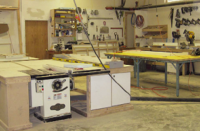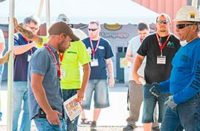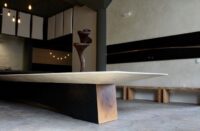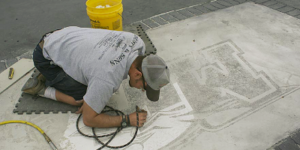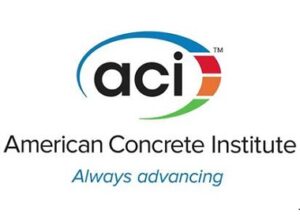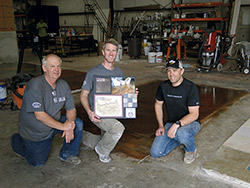
Almost all manufacturers of decorative concrete systems and equipment offer some sort of training on their products. Whether it is a one-hour watch-and-learn or a three-day hands-on class that people pay to attend, these programs have become mainstream in our industry.
Over the last few years, I became concerned when I noticed a sharp decline in attendance at decorative concrete training programs in general. Having personally taught and attended many different types of classes in this industry over the years, I wanted to change this trend. I wanted to expand on the traditional programs that had become a bit stale, in my opinion.
The industry has done a great job of training thousands of installers on the nuts and bolts of what the products are, how they are mixed and the best way to apply them. But in doing my research, I found that most training programs or demos offered no direct connection to how these products are used to make money on actual jobs. Information was provided on types of projects best suited for the material and price ranges were presented by market, but there never seemed to be a real story of what had been accomplished with these materials and what was involved in accomplishing a successful job. Don’t get me wrong, these trainings are all well and good, but I wanted more — something new!
My vision was to train people using past successful jobs as case studies. These case studies would consist of a variety of successfully installed decorative concrete projects. All the details of each job would be made available, including materials cost, labor cost, tools required, materials list, cost per square foot and final profit.
Each case study would first be presented in a classroom setting with emphasis on how each specific job was sold to the client, along with any special circumstances. An architectural display board would be used to show the different phases of selling the project, including an artist’s rendering of the job, physical material samples, and photography of the actual finished project. These architectural display boards would also show by example what a powerful sales tool they can be in setting yourself apart from the competition.
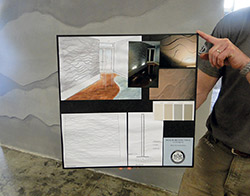 The second phase would involve hands-on training. A 100-square-foot portion of the actual job would be replicated with the help of those in attendance. This approach would provide a map for trainees of all the steps involved in selling and installing a project — based on an actual job that was successful and profitable.
The second phase would involve hands-on training. A 100-square-foot portion of the actual job would be replicated with the help of those in attendance. This approach would provide a map for trainees of all the steps involved in selling and installing a project — based on an actual job that was successful and profitable.
For this new training concept to work, the case studies needed to be projects that used traditional decorative materials to get results that were anything but traditional. This is when I contacted my good friend, decorative concrete installer Chris Becker. Chris was until recently the owner of Becker Architectural Concrete, based in St. Paul, Minn., and is in my opinion one of the best when it comes to taking basic decorative concrete materials and turning them into amazing contemporary and classic decorative concrete finishes.
The project case studies had to be of award-winning caliber but easy to understand and comprehend for those in attendance.
For the first training, we selected decorative overlays as the base material and incorporated stains, dyes and textures into the mix to round out the products used. We also brought in Tamryn Doolan, president and CEO of Surface Gel Tek, for her expertise in stencils, gelled acids and logo designs. Lastly, we needed a partner who would provide a location and customer base so we could give our new training concept a test drive. The easy choice was Murray Decorative Concrete Supply, in Shawnee, Kan. Mike Murray, the owner, has been an advocate for education and training in the decorative concrete industry for years.
On March 16 and 17, 2012, a select group of 16 decorative contractors attended our new approach to training at Murray Decorative Concrete Supply. Four distinctive case studies were presented, each providing a different focus and finish:
- A multicolor variegated microtopping with acid stain
- A banded-texture (slate and wood plank) overlay with stain wash
- A hard-troweled microtopping with free-form stenciling
- A three-dimensional vertical microtopping
As with anything new, the training started a bit slow as the attendees were a bit tentative about this format and what they were being shown. But once they saw the way our new concept was unfolding, they all became completely engaged.
 The case studies were presented individually. Chris Becker provided the story behind how each project, developed from concept to reality. The details of each project were discussed through the use of PowerPoint presentations, with specifics provided on sales techniques, materials used, labor, and overall project costs and profitability. Once the classroom portion of the training was complete, the class moved to slabs for the hands-on application of materials. With the details from the morning classroom session still fresh in everyone’s mind, all in attendance took part in replicating portions of each case-study project. It was impressive to watch as those in attendance worked with Chris Becker, Tamryn and me as a team to make each case study mock-up resemble the original piece as represented on the architectural display board. The final result was four professional representations of the original work.
The case studies were presented individually. Chris Becker provided the story behind how each project, developed from concept to reality. The details of each project were discussed through the use of PowerPoint presentations, with specifics provided on sales techniques, materials used, labor, and overall project costs and profitability. Once the classroom portion of the training was complete, the class moved to slabs for the hands-on application of materials. With the details from the morning classroom session still fresh in everyone’s mind, all in attendance took part in replicating portions of each case-study project. It was impressive to watch as those in attendance worked with Chris Becker, Tamryn and me as a team to make each case study mock-up resemble the original piece as represented on the architectural display board. The final result was four professional representations of the original work.
I understand that not all trainings can be as in-depth as this new approach, but the experience once again confirmed that the decorative industry thrives on innovation and challenging the norm.
